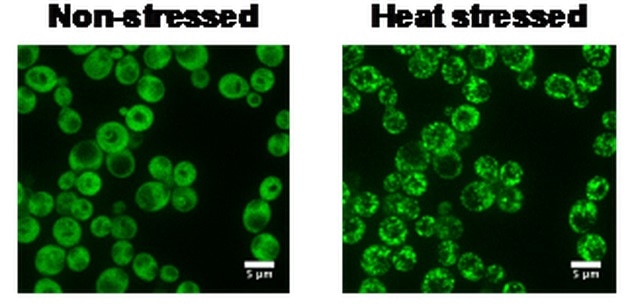Environmental conditions are subject to enormous variations. For example, temperatures in Germany can vary from a hot 40 °C in the summer to a freezing −20 °C in the winter.

The Ded1p protein of baker's yeast changes from a diffuse state (unstressed green cells, left) to a state in which it forms dense structures (heat-stressed green cells, right). The transition is caused by the process of phase separation and is triggered by an increase in ambient temperature. The Ded1p protein was genetically labeled with a green fluorescent dye. Image Credit: Technische Universität Dresden/BIOTEC.
Organisms that find it difficult to cope with such temperature variations will not be able to survive and therefore their genetic information will not be passed on to the next generation.
In a world where people are faced with constantly rising average temperatures caused by global warming, they should ponder on these questions, how do the organisms respond to fluctuating temperatures? What kinds of molecular mechanisms are used by them?
Many years of research have demonstrated that different kinds of organisms react quite similarly to changes in temperatures. The cells of the organisms stop growing when these creatures are exposed to heat, shutting down the generation of housekeeping proteins needed for reproduction and growth.
Instead, the organisms begin to produce proteins that guard the cells against being damaged by heat. This means the cell factory modifies its protein synthesis.
But it is not known which kind of mechanism activates the production change and how the cells are able to detect heat stress.
Baker’s yeast as a model organism
A research team from Technische Universität Dresden’s (TU Dresden) Biotechnology Center (BIOTEC) and the Max Planck Institute for Molecular Cell Biology and Genetics (MPI-CBG), along with associates in Toronto, Canada, and Heidelberg, has examined these underlying questions.
The researchers used baker’s yeast, a well-known model organism in the cell analysis. This single-celled organism comes from brewing beer and baking bread and provides a better understanding of the fundamental processes of life because it contains virtually the same composition as animal and human cells.
If individuals interpret the molecular processes that take place inside the yeast cell, they can also gain a deeper understanding of the development of diseases that occur in complex organisms, like humans.
In yeast, we were able to identify one critical protein, Ded1p, which changes its structure upon heat stress and then reprograms the cell machinery. In the laboratory, we simulated the behavior of Ded1p with purified components and observed the following: Under normal conditions, Ded1p is evenly distributed in the cytoplasm of cells, but when the temperature rises, it assembles into dense structures, using the process of phase separation.”
Christiane Iserman, Study Lead Author, Technische Universität Dresden
Iserman continued, “The fact that Ded1p is able to sense temperature suggests that this protein is a kind of thermometer inside the cell.”
The researchers also analyzed the cell’s consequences when these dense structures are formed by the Ded1p protein.
They are telling the cell to downregulate the production of housekeeping proteins, and to ensure that the production of stress-protective proteins is upregulated.”
Chrisitine Desroches Altamirano, Study Second Author, Max Planck Institute for Molecular Cell Biology and Genetics
Results may help better understand neurodegenerative diseases
This highly sophisticated mechanism does not appear to be restricted to baker’s yeast. The scientists discovered that the Ded1p proteins found in other organisms are quite adapted to the respective habitat’s temperature.
This suggests that evolution has endowed our cells with a high thermal sensitivity so that living organisms can adapt to temperature fluctuations. This gives us hope that organisms will be able to cope with global warming.”
Simon Alberti, Study Lead and Professor, Technische Universität Dresden
Alberti continued, “However, our discovery may have an even more general relevance: We have discovered a mechanism within the cell that helps the organism to deal with a variety of changes in the environment, not just heat stress. Cells seem to be able to deal with a wide variety of environmental signals by using proteins that phase separate to run different gene expression programs.
“In further studies, we want to determine whether this mechanism can help us understand human diseases - primarily those in which our cells do not process certain stress situations properly, as it appears to be the case in age-related neurodegenerative diseases,” Alberti concluded.
Source:
Journal reference:
Iserman, C., et al. (2020) Condensation of Ded1p Promotes a TranslationalSwitch from Housekeeping to Stress Protein Production. Cell. doi.org/10.1016/j.cell.2020.04.009.